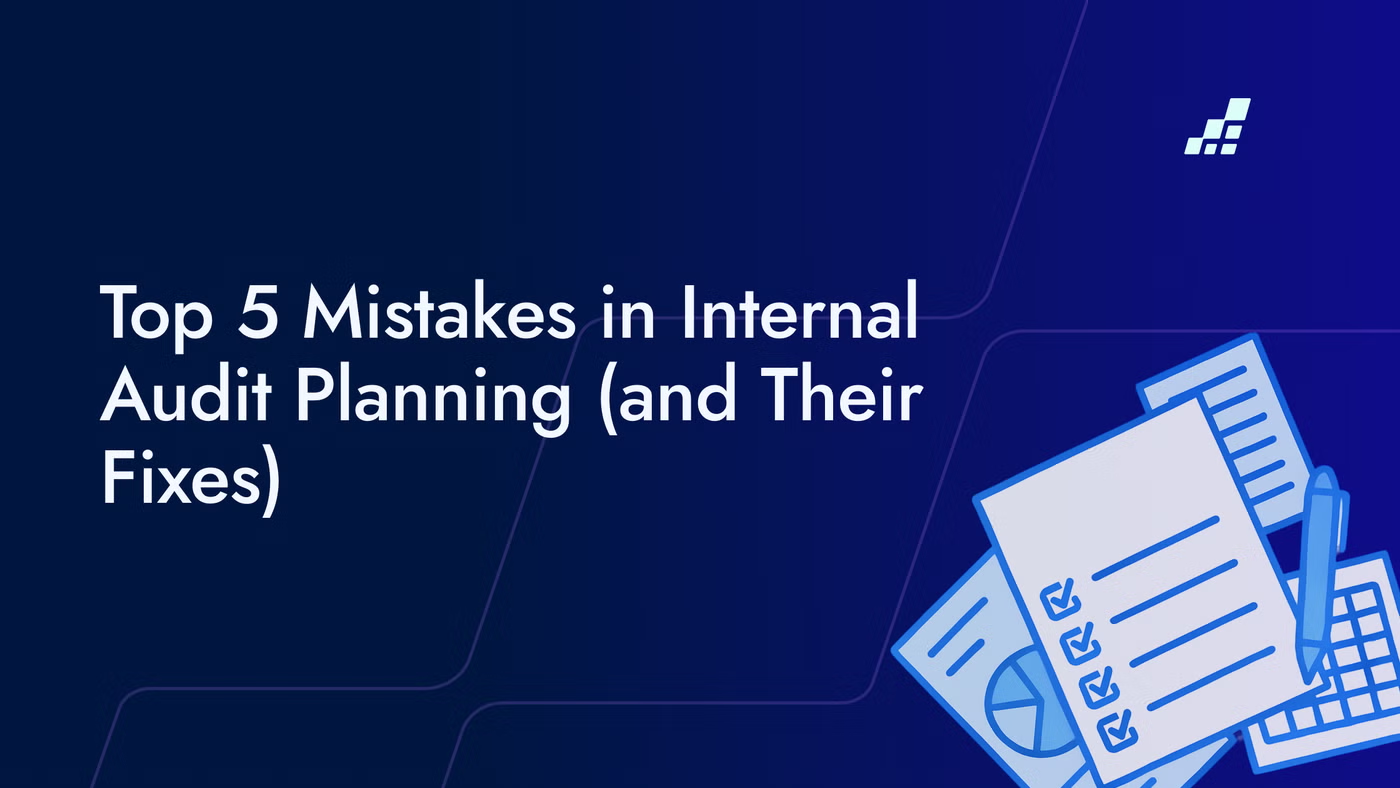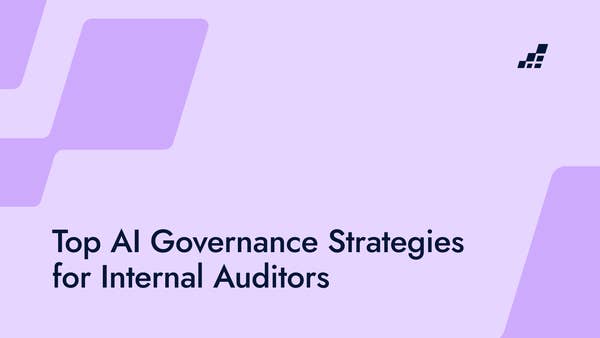- /
- Blog
Top 5 Mistakes To Avoid In Internal Audit Planning

You’re staring at another audit plan. It’s cluttered, half-updated, and somehow missing the riskiest areas. Fieldwork starts in two weeks. Leadership just flagged a system rollout that didn’t make it into scope.
Manual updates in scattered spreadsheets can’t keep pace. Workpapers live in shared drives, control tests in email threads, and every change means another version lost in the mix.
Sounds familiar?
This guide shows where audit planning typically stalls, and how teams use automation and tighter workflows to keep plans current, evidence linked, and high-risk areas covered.
Common Challenges in Internal Audit Planning
Across thousands of internal audit teams, the same patterns emerge:
- Control testing is repetitive and manual: As noted in KPMG’s 2023 handbook on internal controls, many audit teams still rely on scattered spreadsheets and shared drives, which introduces risk and inefficiency.
- Tools are complex and slow to adopt: Many audit tools promise automation but deliver complexity. Internal auditors often resort back to Excel because it’s what they know. That’s why embedding automation in Excel changes the game. It enhances the familiar without adding friction.
- Regulations shift fast, and plans can’t keep up: Whether it’s SOX, GDPR, or sector-specific mandates, regulations evolve fast. Keeping audit plans version-controlled, and risk registers tied to external changes, is essential. Tools that auto - flag regulatory risks help you respond faster.
- Deadlines force shortcuts: Tight audit cycles lead to skipped steps or shallow documentation. Automating repetitive tasks like sampling and evidence collection gives teams back the hours they need to do quality work.
- There’s a talent crunch across the profession: Junior auditors want meaningful work. They don’t want to copy-paste or sort PDFs for hours. Smarter tooling reduces grunt work and improves retention.
The Top Mistakes in Internal Audit planning (and Fixes)
Internal auditors aren’t short on insight. They’re short on time,a nd often equipped with tools that do not support them. Let’s look at the top planning mistakes, and how intelligent automation fixes them without requiring a process overhaul.
1. Strategy Misalignment
The fix:
- Interview leadership each quarter to surface evolving risks
- Create a strategy-to-audit matrix that updates in real time
- Use automation to flag gaps between high-risk areas and audit coverage
2. Shallow Risk Assessment
The fix:
- Pull exception data directly from ERP systems
- Standardize scoring with consistent impact and likelihood criteria
- Use dashboards to track high-risk trends over time
- Create a continuous auditing strategy
3. Weak Stakeholder Engagement
The fix:
- Map key internal stakeholders and their needs
- Run short planning workshops to cocreate audit scope
- Procure the necessary documents from stakeholders
- Track engagement levels with participation and feedback metrics
4. Rigid or Static Plans
Audit plans may often become rigid because they’re developed as static, annual documents, rarely revisited unless a major issue arises.
The fix:
- Define triggers for plan reviews (e.g., M&A, IT rollout, regulation change)
- Maintain version control and documented change logs
- Shift from "plan completion" metrics to outcome-based KPI
5. Ineffective Audit Plan Format
The fix:
- Build a centralized audit plan dashboard
- Use visualizations to show timelines, risk heatmaps, and open items
- Link audit steps directly to source documents
Use Case Deep Dive: Where Intelligent Audit Planning Starts
SOX Controls and Control Testing
Operational Audits
Automation can eliminate repetitive test steps and centralize work into a single view. From matching purchase orders to verifying provisioning logic, audit teams can get a clearer, real-time picture of business processes. This structure goes beyond just improving accuracy. It also helps auditors focus more on judgment, less on chasing files.
IT Audit
Review and Reporting
Automation makes the reporting process more efficient. Control objectives can be tagged, conclusions extracted, and reports cross-referenced with source material - all in one flow. Version comparison tools also reduce back and forth during draft reviews, making it easier to spot changes and finalize findings with confidence.
SOC Report
Automation can help auditors extract key controls, test results, and exceptions quickly, without flipping between tabs or typing line by line. With searchable documents and standardized templates, teams can focus on risk, not admin. The result: faster reviews, stronger documentation, and clearer insight into service provider controls.
Custom Use Cases
Who does audit automation support in internal audit?
- For junior auditors, audit automation removes repetitive grunt work like document gathering and file comparisons. That means more time spent learning audit judgment and less time copying data between tabs.
- For senior auditors, automation means faster, clearer workpapers. Tasks like control testing and walkthrough reviews are smoother, and there’s more room to spot actual issues, without spending late nights chasing evidence.
- For chief audit executives, automation gives visibility without micromanagement. It enables teams to deliver quality, consistent work at scale, while keeping audit aligned with fast-moving business needs and modern tech standards.
“Since we’ve implemented DataSnipper it has greatly reduced the time spent documenting and reviewing workpapers. We are constantly evaluating ways to continue to leverage DataSnipper for SOX testing and operational audits. Looking forward to the increased time savings as we continue to integrate the use of the tool.” Victoria Sporn, Audit Manager - SOX & Financial, MarketAxess
From the Field: How Internal Auditors in Aviation use Automation
So how does using automation for internal audit play out in real time? Frontier Airlines has put these principles to work. Their internal audit team adopted automation and shifted toward a more strategic approach, which helped cut down manual tasks, expand audit coverage, and build stronger partnerships across the business. See what they had to say:
Smarter Internal Audit Starts With the Right Planning Tools
Internal audits need more than processes. With automation built into Excel, audit teams can plan faster, test smarter, and adapt in real time. Intelligent audit planning doesn’t require a system overhaul. Just better tools in the platform auditors already trust.
Frequently asked questions
What is internal audit planning?
Internal audit planning is the process of identifying and prioritizing risk areas in an organization, defining audit objectives, and determining audit scopes and timelines. A strong plan ensures that internal audits are aligned with business strategy and regulatory expectations.
How can automation improve internal audit planning?
Automation helps internal audit teams by reducing manual tasks like control testing, data extraction, and documentation. This frees time for deeper analysis and improves the accuracy of audit trail.
What are the most common mistakes in internal audit planning?
Top mistakes include misalignment with strategy, shallow risk assessments, limited stakeholder engagement, rigid plans, and scattered documentation.
What tools do internal auditors use to build smarter plans?
Many teams rely on Excel for planning, but modern internal audit tools like Datasnipper now integrate automation directly within Excel. This allows for real-time risk tracking, version control, and linked evidence without disrupting familiar workflows.
How often should internal audit plans be updated?
Best practice is to review and refresh audit plans at least quarterly, especially after significant business events like mergers, system changes, or regulatory updates.
How does DataSnipper support internal audit teams?
DataSnipper automates repetitive internal audit tasks directly in Excel, including control testing, document matching, and evidence tagging. This helps teams move faster, maintain compliance, and spend more time on high-risk areas.

.png?width=600&quality=70&format=auto&crop=16%3A9)
